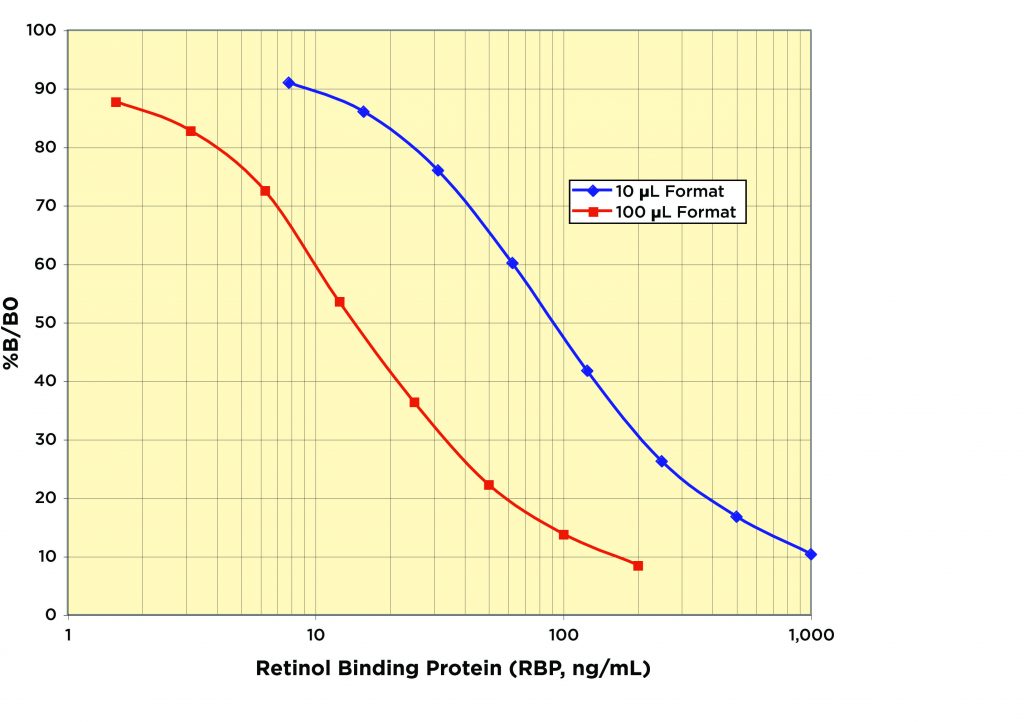Features
- Two format options in one kit
- Fast: Results in 90 minutes
- Stable: Liquid reagents stable at 4°C
- Economical: 38 or 230 samples in duplicate
- Validated sample types: Serum, Plasma, Urine and Dried Blood Spots
The World Health Organization has estimated 250 million children have moderate to severe Vitamin A deficiency (VAD) due to lack of adequate nutrition and the rising cost of food staples around the world further exacerbates this problem. In addition to nutritional deficiencies, infectious stresses have been shown to depress retinol concentrations causing individuals with diseases that interfere with adsorption or storage of vitamin A such as cystic fibrosis, pancreatic insufficiency, duodenal bypass, celiac, cirrhosis etc. to run the risk of VAD.
Retinol binding protein (RBP) is from a family of structurally related carrier proteins that bind small hydrophobic molecules such as bile pigments, steroids, retinoids and lipids. RBP has a hydrophobic pocket which binds retinol (vitamin A) in a 1:1 stoichiometry. This serves not only to solubilize retinol but also to protect it from oxidation. Vitamin A status is reflected by serum concentration as it is homeostatically controlled and does not fall until stores are dramatically reduced. RBP has been shown to be a useful surrogate marker for retinol because of the correlation between retinol and RBP in serum, which implies that RBP can be used to monitor vitamin A deficiency.
RBP has also been shown to be a marker for renal function as it is totally filtered by the glomeruli and reabsorbed by proximal tubules. This makes RBP a useful tool to study renal function in heart or kidney transplant recipients, type 1 and 2 diabetics, and in people exposed to uranium from mining operations. Measurement of RBP levels has also been useful in detection and characterization of diseases including hypertension and certain cancers, among other conditions.
The New DetectX® Retinol Binding Protein (RBP) Multi-Format EIA Kit, K062-H, is designed with two format options, a 10 µl format (7.8 – 1000 ng/mL) and a 100 µl format (1.5 – 200 ng/ml) allowing for the measurement of RBP in a variety of sample types including serum, EDTA or heparin plasma, urine, and 1/8”-1/4” dried blood spots from both healthy and vitamin A deficient individuals. This kit uses native human RBP as a standard, the concentration of which has been established via amino acid analysis. Standards or diluted samples are pipetted into a coated microtiter plate and RBP-peroxidase conjugate is added. The binding reaction is initiated by addition of an RBP-specific polyclonal antibody. After a 60-minute incubation, the plate is washed and TMB substrate solution is added to each well. After 30 minutes, the intensity of the generated signal is read at 450 nm in a microtiter plate reader.
Typical Standard Curves
(Note: This kit provides for two different format options to extend the range of the assay. Most commonly, the 10 µL format would be recommended for serum and plasma samples, while the 100 µL format would be recommended for urine and dried blood spots. Further information on how to choose which standard curve to run for your assay can be found in the kit protocol)

